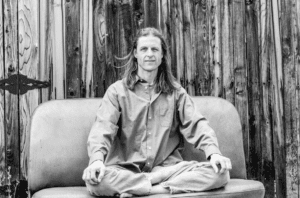
First, a word of thanks to all of those who extended their good wishes, food, and prayers after I broke my leg some three weeks ago. I’m happy to say that the force of healing is alive within me and I make noticeable progress each day. In part, I attribute this healing to repetition in meditation.
As an offshoot of that healing process, I started to offer a free, online meditation course on Wednesday and Friday mornings, 7:30-8:10am. The class consists of a brief asana practice, opening mantra, followed by pranayama, then meditation proper, and a closing mantra. Admittedly, it starts abruptly to ensure we cover these synergistic practices. We don’t discuss theory so much as, well, just get started.
So, I want to give a little context and share one simple idea underlying our practice. That is simply this, “repetition in meditation”. Repetition is integral to any discipline; whether it be learning the violin, fostering a loving relationship, or advancing spiritual growth. The journey of 1,000 begins with the first step. And then the next step. And then the next step…. repetition.
There is a fairly well-known expression within meditation circles:
“Better to dig one deep well than many shallow holes.”
For this reason, the repetition in meditation technique I present remains the same for the remainder of the series. My hope is that we get enough of a footing on the method that it becomes a part of us – to give it a fair chance to positively shape the way we view ourselves and our world.
Adopting a single technique for forty days is a common benchmark to get acquainted with a technique. After those forty days of repeated practice, you can adequately assess if you wish to continue, or not. There is an overwhelming chance that you will see the benefit and want to continue, you will have seen the value of repetition in meditation.
At the same time, we live in a culture obsessed with variety, innovation, and distraction (largely for commercial purposes). Methodical repetition is antithetical to the pace of modern life (though that seems to be on hold for the moment). However, to develop mastery, or better yet, to develop mastery of your mind, body, and character it takes more than one try. With persistent effort, you will discover the benefit. The meditation class is here to support you to develop that skill. Of course, I’d encourage you to practice outside of class as well.
“The beginner has many options, the master very few.”
The beginner has many options, the master very few. As you develop your meditation practice, I invite you to embrace repetition. Through repetition in meditation, gradually clear away the dust and grime that obscures the inner-mirror. This inner-mirror aids you to see yourself more clearly, to dismantle fear and anxiety and reflect greater peace and joy back upon you. But it doesn’t all happen by itself, it requires repetition.
Dates & Times:
- Present through May 1st, 2020
(May extend depending on interest) - Wednesdays and Fridays, 7:30-8:10am.
- Online Zoom entry-link provided with registration
= Free of Charge =



